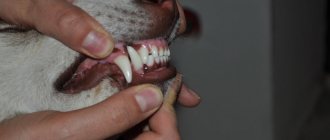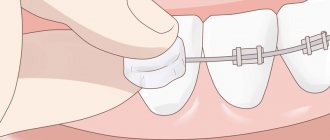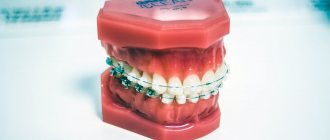Trema - spaces between teeth - are normal in preschool children due to the natural process of growth and replacement of baby teeth. Gaps occur because baby teeth are small and a child's jaw is growing - meaning gaps between teeth are part of the life cycle of a person's teeth.
This is a normal condition for baby teeth.
However, with a permanent dentition this is both an aesthetic and an orthodontic problem.
- The teeth are loosely spaced and do not have sufficient support, so they are more prone to loosening due to the stress of chewing. The risk of gum pockets, exposed tooth necks, and periodontitis increases.
- Food particles get into the teeth and remain there (especially if you don’t brush your teeth well enough), causing the formation of plaque, and then tartar.
- Hard pieces of food can get between your teeth and injure your gums.
- Diction may be impaired, especially for the sounds [c], [w]. Speech will become whistling.
Therefore, as with other defects in the location of teeth, there is a rule: first of all, this is a violation that requires treatment, and only then an aesthetic defect.
Several reasons for the formation of three
- Partial edentia. If some teeth are missing, the extra space in the row of teeth causes teeth to appear. The most common congenital absence of the second incisors in the upper jaw, then fangs are pulled in their place. Due to the difference in shape, these teeth cannot touch tightly, so there are almost always gaps between them.
In place of incisors - fangs
- Partial loss (removal) of permanent teeth.
- Anomaly in the size and shape of teeth (small teeth) and disturbances in their location.
- Biting tongue, lips. If this habit develops during the development of the permanent dentition, it can cause the teeth to become incorrectly positioned.
- Wide and low attached frenulum of the upper lip. Promotes the appearance of a diastema - a gap between the upper incisors.
Diastema
Types and symptoms
The main symptom of this pathology is the presence of a visible distance between adjacent teeth.
Depending on the cause, diseases are divided into two groups: physiological and pathological. Each group has its own characteristics of manifestation and methods of treatment.
Physiological
This group includes those types of pathology that occur in childhood during the period of change of temporary teeth to permanent ones . The main reason for this phenomenon is considered to be the active growth of bones, including the jaw.
Pathology is characterized by the presence of gaps in the anterior and lateral parts of the dentition, including the premolar. The interdental distance can reach 3–5 mm. The teeth have a standard width and height.
Basically, the anomaly disappears after the formation of a new row of permanent teeth .
Pathological
Tremas of the pathological type develop only after the complete formation of the dentition and permanent occlusion.
Since there are many reasons for the appearance of pathological symptoms, the symptoms will depend on the provoking factor.
The only common symptom for this group is a constant increase in gaps , which become more pronounced with age.
Fix three
The treatment plan depends on which malocclusion the three are combined with: for example, an open bite is a fairly serious pathology, and its correction takes up to a year and a half.
It is impossible to correct only trema, as this will lead to even greater disruption of the contacts between the teeth, so it is necessary to carry out complex treatment.
Doctors do not recommend eliminating trema using veneers or dental restoration. In fact, this is only concealing the disorder, and not treating it - all associated problems will remain and continue to get worse.
Are aligners suitable?
In most cases, clear aligners are suitable for correcting malocclusion, so they can be chosen as an alternative to braces.
The result of treatment with Star Smile aligners can be simulated and seen using 3D visualization on a computer. Here's an example of what it looks like:
Thanks to such visualization, it is clearly visible what result can be achieved, and the treatment period is also known in advance.
The trems themselves contract very quickly. Therefore, the duration of treatment depends more on what disorders accompany them.
Remedies
Photo: how to remove cracks between teeth
In order to prevent complications or tooth loss, it is recommended to stop this problem in a timely manner. To do this, you need to visit a dentist who will make an accurate diagnosis and prescribe adequate treatment.
Only pathological trema requires treatment. To eliminate this defect, clinics use two types of techniques: orthodontic and orthopedic.
For one of the three ways to eliminate it, watch the video:
Orthodontic
Orthodontic includes methods aimed at changing the position of teeth and adjusting the length of the jaw arch. For treatment, special removable and non-removable devices are used.
For children under 12 years of age, removable structures are used , which are gentle and highly effective:
- orthodontic plates;
- elastopositioners;
- aligners, correcting arches.
The choice of device is made only by the dentist, based on individual anatomical and physiological characteristics.
Fixed devices are used in children over 12 years of age and adults . Braces serve as a permanent structure.
Now, any clinic can offer various types of braces, differing in the type of fastening, material of manufacture, principle of corrective action and cost.
Regardless of the orthodontic method, it will take quite a long time to eliminate this defect.
If small gaps form, the result can be obtained in 6–8 months. In the presence of more severe pathology, treatment may take up to 1.5 years.
Orthopedic
Orthopedic treatment is aimed at visually eliminating the problem using corrective agents.
To eliminate the defect, they most often use:
- Ceramic onlays (veneers, lumineers).
They are thin plates that are used to cover the front surface of the enamel. Used with small interdental distances of up to 3 mm. Installing veneers has a small drawback - preliminary preparation of the tooth. - Restoration with a composite is the most budget option.
The technology is similar to installing veneers, but instead of ceramic plates, composite onlays are used. It has a number of disadvantages: it also requires minimal preparation, low aesthetic properties and a short service life due to the softness of the material. - Crowns .
In case of pronounced gaps, the defect is eliminated with the help of crowns, for which a material is used that accurately conveys the transparency and shade of a natural tooth. Using this method, you can hide scars located throughout the entire dentition. Its disadvantages: deep grinding of the enamel and killing of the nerve, even with a healthy tooth. - Implantation .
It is used if the cause of the defect is partial absence of teeth. The procedure has a lot of contraindications and should be carried out only after a thorough examination.
How does diastema of the upper teeth differ from similar pathologies?
In a separate article we will find out what an orthodontist treats.
Follow the link https://orto-info.ru/sistemyi-vyiravnivaniya-zubov/lechebno-profilakticheskie-apparatyi/treyneryi-dlya-tsena-na-razlichnyie-vidyi.html we will look at how much dental trainers cost and what affects this index.
Star Smile offers you a free consultation with an orthodontist to correct three in your city!
And it's not a joke.
The Star Smile company is represented by certified orthodontists in more than 70 cities of Russia and we can offer you a unique opportunity - to simulate your future treatment result in three BEFORE it begins. If you like it, you can decide for yourself which way you want to correct the tremors - with aligners or another alternative method. And do you need to correct the three? Since Star Smile is a leading Russian manufacturer of mouth guards for teeth straightening, our prices for treatment of three teeth are truly the most comfortable for you. And the consultation is free. Would you like us to sign you up for a free consultation on correcting three in your city?
How to deal with trema?
The good news is that trema can be corrected. First of all, the dentist examines the patient’s teeth, determines the cause of the defect, and then prescribes treatment. For example, if an open bite is to blame, you need to start by correcting this pathology.
In general, in modern dentistry the following methods are used to treat three:
- artistic dental extensions;
- special orthodontic devices;
- braces;
- mouth guards;
- veneers and lumineers;
- installation of a crown.
The dentist will determine which of these methods is right for you. The main thing is not to neglect the problem and seek help from a specialist in time. After all, if the external manifestation of trema can be made your highlight, then dental diseases can hardly be called a plus.
Varieties
Diastema can be different. Experts divide types of defects according to the type of displacement, location, and etiology. Symmetrical diastemas are most common. The incisors are at the same distance from the bridle. With an asymmetrical defect, only one incisor is displaced.
If the roots are located correctly, and only the crowns diverge, they speak of their lateral deviation. As a rule, this is a consequence of the presence of supernumerary units and bad habits.
Corpus lateral displacement implies deviation of the entire dental units. Such a defect is observed when the middle suture on the bone tissue is compacted, the lower attachment of the frenulum, or congenital adentia.
The most complex type of diastema is the medial slope. In this case, the cutters are deviated from the center and rotated along their axis. The reason for this may be supernumerary units or odontoma. This is the name given to a benign tumor located in the jaw bone.
Which method is better?
The only reliable method of completely eliminating gaps between teeth is orthodontic treatment. Only it can cure pathology, and not just disguise it. This treatment is the most long-term method of correcting three. However, it is less traumatic for teeth, since it does not require turning, grinding and other procedures required for aesthetic correction. For children under 12 years of age, dentists prescribe special orthodontic plates, which they wear for some time. From the age of 13, braces are allowed. Thus, trema can be cured only with the help of special orthodontic structures that will need to be worn for a certain time. Aesthetic correction methods, such as installing veneers, crowns or extensions, do not eliminate the problem, but only make it invisible to others. The patient and the doctor decide which method to use. If the three holes are not very large and do not cause problems, you can limit yourself to installing veneers or extensions. If the defect is severe or causes discomfort, you will have to undergo orthodontic treatment. After it, the teeth will take the correct position, and the gaps between them will disappear.
Plates are removable orthodontic structures used to treat dental anomalies. They are completely safe because they do not provoke allergic reactions and do not injure the oral mucosa.
Tremas and diastemas - what is the difference?
Tremas and diastemas are approximately the same thing - gaps between teeth, the dimensions of which are beyond normal limits. The main difference between these pathologies is the location of the gaps.
Important! Diastemas are spaces between the central incisors that can occur on both dentitions. Trema can form anywhere, both in front and on the sides. They also affect both the lower and upper teeth.
Many people have dental defects such as diastemas and trema. According to statistics, almost every fifth person has an abnormally wide gap between the teeth. Most often they form on the upper dentition. Units in the lower row are less susceptible to this pathology. For most people, trema and diastema cause absolutely no concern. They live quietly, not paying any attention to this defect. And some, on the contrary, are even proud of such a gap, considering it an integral element of their image. Such people are not shy about smiling and showing their teeth to others. But most owners of three teeth between teeth still consider this a significant drawback and strive to get rid of it as soon as possible. Modern dentistry allows you to easily eliminate the defect, making your smile beautiful. In addition, dentists themselves recommend their patients to have their teeth corrected to avoid various problems.
Prevention of diastemas
To ensure that thoughts about how to remove gaps between teeth at home or in any other way in your children never occur to you, you should adhere to two basic rules.
- It is necessary to rid the child of habits harmful to teeth and teach him proper oral care, which will eliminate various diseases that may affect the further development of the gap between the front teeth.
- Follow a schedule for visiting the dentist so that he can identify deviations in time and prescribe the necessary treatment. And although the appearance of a gap between the front teeth in a child under one year of age is nonsense, its appearance in adolescence is quite likely if prevention of this problem in childhood is ignored.
Diagnosis of diseases
During a visit to the dentist, the doctor must correctly establish a diagnosis in order to determine the severity of the case, plan further actions and select a method of correction. In some cases, a visual inspection is not enough. Then the orthodontist will refer the patient for an x-ray or tomography. Here it is important to exclude or confirm the presence of bone tissue in the problem area. The image will also allow you to see the location of the roots in the jaw and detect underdeveloped tooth buds.
Reviews
Eliminating gaps is an extraordinary task that does not tolerate a formulaic approach. Its solution is approached individually and professionally, so that the chosen technique does not provoke complications and does not affect the health and functioning of the organs of the jaw row and the oral cavity as a whole.
If you are familiar with this situation firsthand and are looking for a solution to this problem, you can share your opinion about eliminating the defect in the “comments” section. Perhaps your thoughts or advice will be useful to someone.
If you find an error, please select a piece of text and press Ctrl+Enter.
Treatment: how to get rid of gaps between teeth
There are surgical and therapeutic methods for correcting interdental clefts. Of course, it is preferable to use therapy - this area is dealt with by an orthodontist. The duration of achieving the final result is first discussed with the patient, that is, whether the diastema needs to be removed urgently or within a few months. The price of therapy also plays a significant role.
Let's consider all treatment methods:
- braces: this is the name given to metal, ceramic or sapphire devices that are attached to the teeth for several months in order to form a correct bite, that is, to shift the position of the teeth. The main approach to the treatment of such pathologies, the cost starts from 25 thousand rubles. Suitable for treating numerous three in a row,
- aligners or silicone aligners: alternatives to braces. Also suitable for multiple triplets. Price – from 180 thousand rubles per complex,
- filling or closing with a composite material: the gap between the frontal incisors is corrected with a filling material using the method of artistic restoration of a diastema. The price starts from 4,000 rubles per tooth. This and the methods described below are not used for three, since we are talking only about restoring the aesthetics of the frontal area,
- veneers for diastema: ceramic onlays 0.5-0.7 mm thick. These microprostheses have been used for decades and rightfully hold the palm in terms of the quality of restored smile aesthetics. However, to install them you need to grind down your own enamel, which is not suitable for every patient. Veneers last 10-15 years. The price of 1 element starts from 15 thousand rubles,
- lumineers (these are also plates, but thinner - about 0.2 mm thick). Their advantages are quick and almost painless installation, without grinding down the enamel. Cost – from 30 thousand rubles for 1 record. But such a restoration is only suitable for ideal teeth. Correction by this method is not used if the width of the diastema is more than 7 mm,
- carbon retainers: used in children to tighten the frontal incisors. Installed for a period of 12 months.
As for installing braces and aligners, see an orthodontist. It is imperative to contact him if a child has gaps in a row, regardless of the bite - whether it is milk or permanent. It is important to start treatment as early as possible so that there are no problems in adulthood.
For crowns, veneers or lumineers, you need to contact an orthopedic dentist (also called a prosthetist). These techniques are justified in situations where, apart from cracks, no other bite pathologies are present. And, accordingly, there are no complications.
“Last year I decided to get a filling in place of the gap. I didn't like the way my smile looked, even though my parents and boyfriend said it gave me charm. What can I say – the procedure was not very long, a little over an hour. At first, the filling bothered me; I wanted to push it out with my tongue. But after a couple of weeks I stopped feeling discomfort. But now I really like the reflection in the mirror!”
Oksana I., review from the site irecommend.ru
Surgical methods for treating pathology include the following (they are carried out only in the presence of truly complex pathologies):
- corticostomy: correction of the palatal suture, required if the suture between the central incisors is filled with connective and bone tissue. It is performed under anesthesia. An unpleasant procedure, especially for children. Long-term rehabilitation,
- removal of primary incisors: if their size is very large. The permanent incisors grow to a normal size.
What is trema
Trema between teeth is also observed in many people. Its main difference from a diastema is only in its location. Trema also denotes the interval between teeth, but is located in a different place in the dentition. For example, between the lateral incisor and the canine, the canine and the premolar, etc. With a normal structure, the value of this distance in an adult is up to 0.7 mm. If the gap is more than 1 mm, then the doctor will diagnose “trema”.











